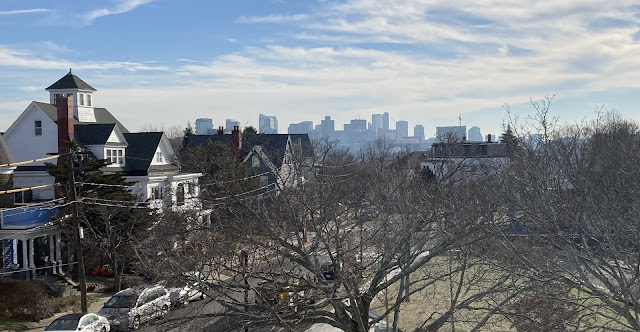The Convention Army Arrives - "The Barracks At Cambridge Near Boston"
I intended this blog post to focus on Cambridge as the final stop of the march of the Convention Army. Two things changed that. The first was learning that while Burgoyne and his senior officers were primarily quartered in Cambridge, his troops were held in Continental Army barracks on Prospect Hill, the site today marked by the magnificent stone tower shown below, and Winter Hill. The second was visiting Somerville, which in 1777 was still part of Charlestown and is where both hills are located.
 The 1777 march of the Convention Army began in earnest on October 18th, with many thinking their destination was Boston. German Grenadier Johann Bense noted in his diary for that day "... we set out for Boston..." [1] A letter dated October 22nd from Greenbush, New York, published in the Massachusetts Spy in Worcester, noted that after grounding their arms, Burgoyne's troops "... marched down to Stillwater, and crossed Hudson's river the 18th in order to march for Boston."
The 1777 march of the Convention Army began in earnest on October 18th, with many thinking their destination was Boston. German Grenadier Johann Bense noted in his diary for that day "... we set out for Boston..." [1] A letter dated October 22nd from Greenbush, New York, published in the Massachusetts Spy in Worcester, noted that after grounding their arms, Burgoyne's troops "... marched down to Stillwater, and crossed Hudson's river the 18th in order to march for Boston."
The thought of housing prisoners "... in, near, or as convenient as possible to Boston" in accordance with Article IV of the Articles of Convention upset the residents of Boston and surrounding towns. Bostonians remembered the quartering of British troops in their town in 1768 led to years of strife and discontent. Within days of receiving the news that the Convention Army was heading towards Boston, the Massachusetts Legislature considered how best to deal with their pending arrival, and voted that they be kept in barracks built outside the town in 1775 to house Continental Army soldiers during the Siege of Boston. [2]
The first troops of the Convention Army to enter Cambridge were the British, on November 6th. It was well that Massachusetts officials set forth their limitations in advance. British Ensign Thomas Anburey recounted that as their march neared its end, "It was understood at the convention, that the troops were to be stationed on Prospect and Winter Hill, and the officers were to be quartered in Boston, and the neighboring towns. On this supposition some of the officers had pushed forward and got into Boston, but were immediately ordered out." [3]
Under Article VII of the Convention, British and German officers were "... to be quartered according to rank." Anburey anticipated he and his fellow officers would "... have the towns of Cambridge, Mystic, and Watertown, to quarter themselves, and a parole of about ten miles in circumference... It is no little mortification that I cannot visit Boston, for it is the second city in America, and the grand emporium of the rebellion... we can go as far as the ferry at Charles-town, and are debarred from crossing it." [4] In Watertown though, a town meeting decided on December 15, 1777, "That it is the Opinion of this town that the Quartering the British officers among the inhabitants thereof, at this time, is Very Dangerous to the peace & Safety of the town as Well as the publick, and therefore we Cannot give our consent thereto." [5]
Compounding the discontent of residents in and around Boston were Articles V and XI of the Convention, which provided the captured troops would be supplied with food, firewood and hay for their horses, and that officers would be granted parole - the right to move around in a specified area subject to reasonable limitations - and be allowed to carry their swords. Hannah Winthrop wrote to her friend Mercy Otis that, after the arrival of the Convention Army, Cambridge was "... delugd with British and Hessian [officers] ... who are Prancing & Patrolling every Corner of the Town, ornamented with their glittering Side arms, Weapons of destruction ... It is said we shall have not Less than Seven thousand persons to feed ... Two hundred & fifty cord of wood will not serve them a week ... & little to be purchasd." [6]
Anburey recalled a wet day of marching on the 6th, and arriving at Prospect Hill late in the evening to find the barracks "... were unfortunately in the worst condition imaginable for the reception of troops, being so much out of repair, that we suffered severely from the inclemency of the weather; the barracks were, in fact, bare of everything..." [7] German troops arrived the following day, Riedesel noting that on the 7th "they reached the barracks at Cambridge near Boston." Brunswicker Grenadier Johann Bense found Winter Hill no better than Prospect Hill: "The barracks were only put together with boards. The gables were open. We had no wood nor straw to lie on..." [8]
Next Week: Private David How - "Fixing For A March"
For more on the Convention Army's 1777 march from Saratoga to Boston, see:
1777 March Blog Home Overnight Stopping Points Towns and Villages Along the Way




Comments
Post a Comment